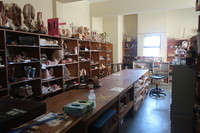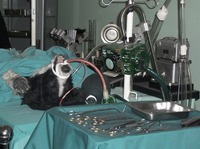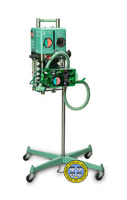Items
Site
The Medicine Chest
keywords is exactly
cardiovascular
-

The workshop
"Held in the Department of Human Biology in the Division of Clinical Anatomy and Biological Anthropology, this collection consists of prepared specimens – both bottled and plastinated, anatomical models – and a skeletal repository used for research purposes. The materials are kept in three separate rooms, with the anatomical models in one, the prepared and plastinated specimens in another and the skeleton repository in its own room behind locked doors, viewable by appointment only. The room housing the anatomical models functioned as a workshop when modelmaking was still offered to first year medical students as an elective course: its walls are lined with shelves that display models made from materials ranging from papier-mâché to modern silicon copies and are taxonomised according to their anatomical representations, such as ‘the eye’, ‘head & neck’, ‘dentistry’, ‘embryology’, ‘lungs’ and ‘cardiovascular system’, to name a few. The models represent each anatomical section and are brightly coloured to differentiate the different parts of the human body and aid in identification. Many of the models can be dismantled into separate pieces and, like a puzzle, be reassembled into their original shapes. Interspersed with these models are rolled-up charts depicting organs, bodily systems and anatomical sections of the body in two-dimensional form, as well as old student modelling projects. A selection of animal skeletons is displayed on the far side of the room, and a shelf with a few anatomical specimens in formaldehyde is across from it" (Liebenberg 2021: 121 - 122). -

Dogs in the Heart of Cape Town
The guided tour of the museum, which commemorates the first heart transplant performed by Chris Barnard in 1967, starts with a representation of the car accident that provided the heart for the transplant, through to the animal lab where Barnard conducted experiments with over 50 dogs to perfect the technique of heart transplantation. From there one can tour a model of Denise Darvall's bedroom and Christiaan Barnard's office before seeing a recreation of the surgery in the actual operating theaters where it occurred. -

Heart of Cape Town Museum
Christiaan Barnard did forty-eight trial transplants with dogs before he undertook such an operation with a human being. -

Bird Mark 7 Respirator
Dr. Bird invented a number of popular medical devices that were used to care for patients with breathing problems. During WWII he served in the Army Air Corps where, in addition to training and transport assignments, he studied aircraft and respiratory and cardiovascular problems at high altitude. Two devices that he produced during the war went into the design of his first commercial ventilator, the Mark 7 Respirator. Dr. Bird’s respirators and anesthesia ventilators have been used during many of the first human surgical procedures. Among these were the first open heart procedure and the first liver transplant.


